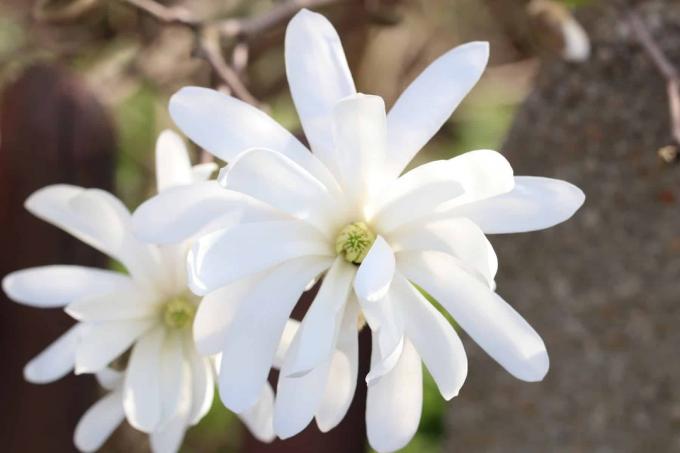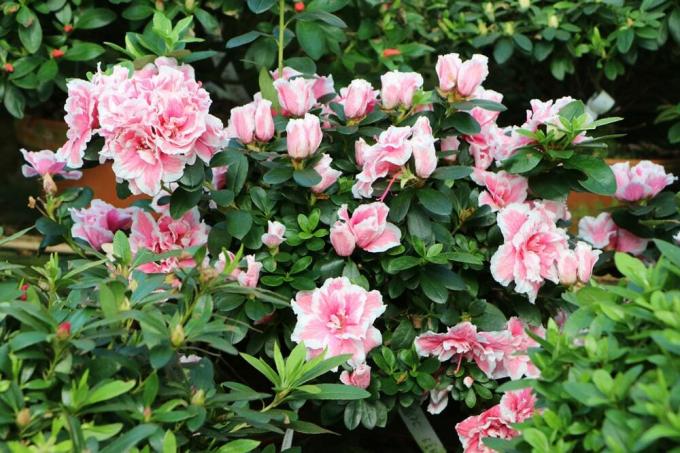

Table of contents
- sowing and location
- plants and repotting
- Suitable neighbors
- watering and fertilizer
- cutting and overwintering
- propagation
- diseases and pests
- Tips for speed readers
- Worth knowing about the star magnolia shortly
The Star Magnolia (Magnolia Stellata) has found its way from Japan to our western regions of the Occident. With its white flowers and tall growth, it looks very elegant and the easy care makes it a hit in the garden, on the terrace or in a large pot in the living room. Those who take little care of the magnolias will be happy with them forever and can multiply them effectively and also expose them to other locations. A little help should give all newcomers the key data for rearing and care.
sowing and location
If you want to sow the red seeds, you should do so immediately after the fruit has ripened. The best spot for sowing is in a box that is out in the cold but protected from the worst of the frost. The seeds need a cold stimulus before they react. As a result, germination sometimes takes place only in the second year. The germs should not be frozen in a block of ice. In a low pot, the plants must also be protected later.
The best location is a moderately sunny spot in the garden. In principle, the plant does well in full sun, but due to the early flowering, too much sun can ensure that it starts too early and the late frost destroys the inflorescences. As far as the soil is concerned, the plant is not demanding. Whether slightly acidic, basic, alkaline or slightly calcareous. If you spread some manure or compost around the plant from time to time, you ensure a sufficient supply of nutrients. Alternatively, small amounts of organic-mineral fertilizers (e.g. for rhododendrons or azaleas) can also be used.
plants and repotting
In principle, repotting the plant is only necessary once. When the plant has germinated in the pot and has already grown a few centimeters above the ground, it can be put outside in spring. If you want to keep the plant indoors and have a certain maximum size, you have to prune it like a bonsai. A deep pot is not necessary for this, as the plant has fairly shallow roots.
Suitable neighbors
As neighbors of the magnolia, deep-rooters are recommended. Stronger shallow roots, such as a chestnut, can rob the magnolia of its energy. In this case, a root barrier must be placed under the tree grate. Fertilizing should also be done more regularly. Particularly suitable neighbors are magnolias in other colors to complement the sight and make it even more impressive.
watering and fertilizer
The plant is also very undemanding when it comes to watering. It should only be watered if it hasn't rained and the soil around the plant looks dry. Waterlogging and too much moisture must be avoided at all costs! The star magnolia prefers it a bit drier than too humid. If you overwater the plant, you will quickly encounter deficiency symptoms. Leaves turning yellowish-whitish are an indication of this.
You should fertilize in spring, when the star magnolia enters the vegetation phase. As described above, simple manure or compost can be used as fertilizer, which is simply raked lightly into the surface. Care should be taken not to damage the roots. You can also use organic-mineral fertilizers. Especially recommended is the one for rhododendrons or azaleas. Mulching around the plant saves fertilizing and even less watering. From time to time the undergrowth, i.e. lawn and co., should be removed and compost or potting soil should be spread. This step is also saved with bark mulch.
cutting and overwintering
If you want to cut back the plant, you should do so indirectly after flowering. In principle, this is not necessary, the plant should only be thinned out if necessary. Annual pruning is not necessary and should even be avoided. Overwintering the star magnolia is simply done outside in the open air. The plant does not need to be cut out and brought inside. However, if you want to have the plant in a small pot, you should protect it from excessive frost and freezing wetness in the pot.
propagation
Propagation takes place either via the red seeds of the fruits, which the plant has developed in autumn, or via Cuttings, which is highly recommended due to the high vigor of the plant and the long germination times of up to 2 years is. The cuttings are cut after flowering. The twigs cut off with rose scissors are first placed in water for a few days and then in soil. As a tip for faster rooting: You can easily do without root boosters from the shop. Tip: Willow water works wonders when it comes to propagating cuttings. Simply remove a few green but woody branches of a willow, in approx. Cut into 2 cm pieces and soak in water for 24 hours. This water is then ideal for pulling roots from offshoots. After the first roots can be seen, it is advisable to leave the plant in a large pot for a month and then plant it outdoors.
Propagation via the seeds takes place as already described: expose and wait in a cool pot full of soil. Despite a cold stimulus, it can take two winters before the germs begin to sprout.
diseases and pests
If the star magnolia has too stressful a location, the leaves will remain small and whitish. To remedy this, one should check whether other shallow-rooters are nearby and install root stops if necessary. The soil must be checked for excessive density, waterlogging and the PH value. The star magnolia is very sensitive to soil compaction and a too high pH value must be balanced with some sulfur powder. However, this practice rarely occurs with our floors. Mulching and fertilizing is enough to keep the plant healthy.
There are few pests: the so-called white fly and the scale insect can be easily combated with conventional pesticides. If leaf spots appear due to the bacterium Pesodomonas, the plant should be watered less. infested stands are removed and cut back.
Tip:
In case of pest infestation, a nettle tincture that is compatible with the environment and health helps. Nettles are collected for this. Soak in water for 1-2 days and then spray the liquid on the plant - helps great against all kinds of lice.
Tips for speed readers
- Anyone who loves tulip magnolias but does not have enough space for their stately growth will find a suitable alternative in the star magnolia.
- The star magnolia is easy to care for. If you fertilize it from time to time and don't water it too regularly, you can enjoy it for a long time.
- The plant can be treated like a mother-in-law.
- Growing up as a bonsai is complicated: it should be expected that the first attempts to keep the plant small and in the pot will fail.
Worth knowing about the star magnolia shortly
Plant
- A front yard is ideal as a backdrop for a star magnolia. In any case, it deserves a place where it comes into its own as an eye-catcher.
- If you want to plant a star magnolia, it is best to do so in autumn or spring.
- Star magnolias prefer acidic soil, similar to rhododendrons or azaleas.
If the soil condition does not match this preference, planting is the best opportunity to change the soil Adjust accordingly: For this purpose, the planting hole should be larger than necessary, so that another sack of rhododendron soil can be used fits in.
- Horn shavings have proven themselves as long-term fertilizers.
- After planting, the soil around the star magnolia must be pressed firmly and the plant must be watered well.
Care
- If the planting took place in autumn, the still young star magnolia absolutely needs protection for the first winter so that it does not freeze to death.
- Late night frosts can damage the flowers of very early flowering varieties, even if the plants are older.
- It is therefore advisable to make sure when buying that the star magnolia belongs to the species that bloom later.
- Star magnolias are grateful for fertilizer in spring. A typical rhododendron or azalea fertilizer.
- If a layer of rhododendron soil is spread around the trunk instead of compost, the star magnolia will also do well.
- Because the roots are very shallow in the ground, vigorous chopping could damage the roots. Therefore it is better to avoid it.
- It is also advisable to apply bark mulch in this area. This suppresses weeds and prevents the soil from drying out as easily.
- To care for the star magnolia, sufficient moisture must always be provided. Especially in the summer when it hasn't rained for a long time.
- Star magnolias do not actually need to be pruned, unless they are too out of shape.
 garden editorial
garden editorial I write about everything that interests me in my garden.
Learn more about shrubs and woody plants

17 flowering hardy plants May to October
Many plants only show their full splendor for a short time. But there are also types and varieties with a particularly long flowering period from May to October, sometimes even longer. We present 17 flowering hardy plants.

25 hardy and evergreen ornamental trees
Ornamental trees are among the most popular plants in the garden. They have a decorative effect and set special accents in the green oasis. If you are tired of the gray of the cold season, you can plant trees that are hardy and evergreen.

Is barberry poisonous? | What is to be considered?
With their dense growth, numerous thorns and evergreen foliage, barberries are one of the most popular types of plants for a hedge in the garden. Before cultivating the sour thorn family (Berberidaceae), many ask themselves whether the plant is poisonous.

Azalea location: 6 important criteria
Azaleas are a flowering addition to the garden or living room, as long as they are in the right location. In the following guide to azaleas, we will tell you what to look out for.

How fast does a rhododendron grow? | Information about growth
How fast a rhododendron grows depends on various factors, including the variety, location and care. Growth can be accelerated under optimal conditions, while deficiencies lead to stunted growth.

Butterfly bush: the ideal location | Buddleia
The uncomplicated, easy-care and robust butterfly bush is suitable in the garden for borders, a flowering hedge or as a solitaire. Dwarf summer lilacs are ideal for pot culture. Buddleia bloom from June to October and are a magnet for many butterflies.
